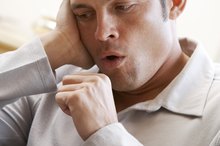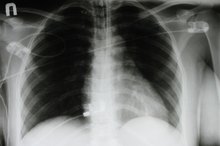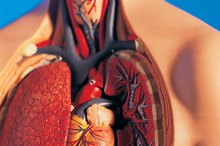Causes of Shortness of Breath With Exercise
Shortness of breath, or dyspnea, may cause you to feel that you can't get enough air in your lungs, or that you are suffocating. You may also experience a tightening sensation in your chest. If you have shortness of breath while exercising, it could be from exercise that is more strenuous than you are accustomed to; extreme temperatures, poor physical condition and high elevations can also play a role. As unexplained shortness of breath may indicate a serious underlying medical condition, consult with your doctor as soon as possible if your shortness of breath is new or is getting worse.
Asthma
Shortness of breath while exercising is sometimes a sign of asthma, which involves a narrowing and swelling of airways. Along with having difficulty catching your breath while exercising, you may cough. Often there will often be a whistling or wheezing sound on exhaling. Exercise-induced asthma can increase when the air is cold and dry. See your doctor if you have signs of asthma.
- Shortness of breath while exercising is sometimes a sign of asthma, which involves a narrowing and swelling of airways.
Bronchitis or Penumonia
Heavy Breathing During Exercise
Learn More
Both the respiratory illnesses bronchitis and pneumonia can cause shortness of breath with exercising. Acute bronchitis, an inflammation of the bronchial tubes, can occur from a cold or respiratory infection; chronic bronchitis -- a constant inflammation -- can result from smoking. With bronchitis you will also cough up mucus, have fatigue, fever and chills, and chest discomfort. Pneumonia, a lung infection caused by bacteria, viruses, fungi or parasites, can be mild or severe. In addition to shortness of breath, you will usually have fever, cough, sweating, chills and pleurisy -- or chest pain -- that changes with your breathing. See your doctor if you have a persistent cough or fever that lasts more than three days.
- Both the respiratory illnesses bronchitis and pneumonia can cause shortness of breath with exercising.
- In addition to shortness of breath, you will usually have fever, cough, sweating, chills and pleurisy -- or chest pain -- that changes with your breathing.
Congestive Heart Failure or Heart Attack
With congestive heart failure, the heart can't pump enough blood to the body's organs. The American Heart Association says this condition can be caused by scar tissue from a past heart attack, high blood pressure, heart disease and endocarditis, an infection in the lining of the heart. Symptoms include shortness of breath on exertion or exercise, along with fatigue and edema -- or swelling -- of feet, ankles and legs. If your shortness of breath worsens when you are lying down, this is an indication that you could be having congestive heart failure. If you have these symptoms, see your doctor immediately. With a heart attack, part of the heart muscle is damaged or dies due to lack of oxygen. If shortness of breath lasts more than a few seconds, or is accompanied by pressure or pain in your chest, sweating, dizziness, nausea or overwhelming fatigue, seek emergency medical care.
- With congestive heart failure, the heart can't pump enough blood to the body's organs.
- If your shortness of breath worsens when you are lying down, this is an indication that you could be having congestive heart failure.
Pulmonary Embolism
Bronchitis and Exercise
Learn More
A pulmonary embolism is a sudden blockage in a lung artery, usually due to a blood clot. With a pulmonary embolism, you will not only have unexplained shortness of breath, but may also have chest pain and coughing. FamilyDoctor.org notes that blood in coughed-up mucus is another indication of pulmonary embolism. The National Heart Lung and Blood Institute says that pulmonary embolisms can be life-threatening; if you believe you have one, seek emergency medical care.
- A pulmonary embolism is a sudden blockage in a lung artery, usually due to a blood clot.
- The National Heart Lung and Blood Institute says that pulmonary embolisms can be life-threatening; if you believe you have one, seek emergency medical care.
Related Articles
References
- MedlinePlus: Breathing Difficulty
- Family Doctor: Shortness of Breath
- American Heart Association: Congestive Heart Failure
- National Heart Lung and Blood Institute: Signs and Symptoms of Pulmonary Embolism
- MedlinePlus: Asthma
- Wahls SA. Causes and evaluation of chronic dyspnea. Am Fam Physician. 2012;86(2):173-82.
- John Hopkins University. Heart & Vascular Institute. Shortness of breath. Updated 2019.
- Whited L, Graham DD. Abnormal respirations. [Updated 2019 Jul 30]. In: StatPearls [Internet]. Treasure Island (FL): StatPearls Publishing; 2019.
- Chourpiliadis C, Bhardwaj A. Physiology, respiratory rate. [Updated 2019 Jan 28]. In: StatPearls [Internet]. Treasure Island (FL): StatPearls Publishing; 2019.
- Abidov A, Rozanski A, Hachamovitch R, et al. Prognostic significance of dyspnea in patients referred for cardiac stress testing. N Engl J Med. 2005;353(18):1889-98. doi:10.1056/NEJMoa042741
- Cleveland Clinic. Emphysema: Diagnosis and tests. Updated August 9, 2019.
- Munari AB, Gulart AA, Dos santos K, Venâncio RS, Karloh M, Mayer AF. Modified Medical Research Council dyspnea scale in GOLD Classification better reflects physical activities of daily living. Respir Care. 2018;63(1):77-85. doi:10.4187/respcare.05636
- Guly HR. ABCDEs. Emerg Med J. 2003;20(4):358. doi:10.1136/emj.20.4.358
- Kasper DL, Fauci AS, Hauser SL. Harrison's Principles of Internal Medicine. New York: Mc Graw Hill education, 2015.
- MedlinePlus. Breathing difficulty. Updated 03/05/18.
- Nishino T. Dyspnoea: underlying mechanisms and treatment. British Journal of Anaesthesia. 2011;106(4):463-74. doi:10.1093/bja/aer040
Writer Bio
Carol Sarao is an entertainment and lifestyle writer whose articles have appeared in Atlantic City Weekly, The Women's Newspaper of Princeton, and New Millennium Writings. She has interviewed and reviewed many national recording acts, among them Everclear, Live, and Alice Cooper, and received her Master of Fine Arts degree in writing from Warren Wilson College.








